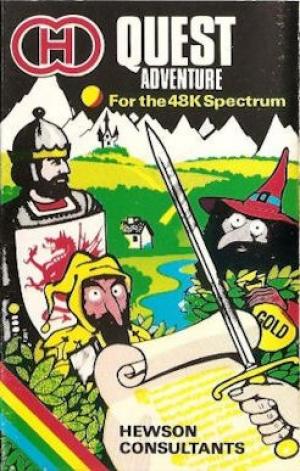

Platform: Sinclair ZX Spectrum
Region: Region Not Set
Publishers(s): Hewson Consultants Ltd.
ReleaseDate: 1983-09-19
Co-op: No
Quest adventure
OBJECT The object of QUEST ADVENTURE is to find a map, hidden in a world inhabited by gruesome monsters guarding their territory and various pieces of treasure. On the way, you must also locate an ancient scroll which will provide you with a valuable clue. CHARACTERS You may play the role of one of five characters, each with its own advantages and disadvantages. Each character has five attributes which vary throughout the game. These are: Strength Luck Dexterity Constitution Charm The Spectrum determines the initial value of each attribute by rolling three imaginary dice and adding the results. The machine also holds a number, known as the Combat Adds, which is used when fighting. This is calculated by adding one point for each point by which each of the first four attributes exceeds 12, and deducting one for each point by which each attribute is less than 9. Should any attribute other than charm fall bellow zero, your character dies and you must start the adventure again. Each character has a maximum value assigned for each attribute. These are as follows: Character Max Luck Dexterity Constit- Charm strength ution Wizard 25 25 25 30 30 Cleric 25 20 20 30 30 Rogue 30 20 15 50 20 Fighter 50 20 10 50 10 Simpleton 40 15 10 40 40 COMBAT When your chosen character engages in combat on your behalf, you must name a weapon and an opponent. Once you have done so, the computer remembers them, even if they cease to exist. Thus you start off by saying, for example, "fight the hobbit with the sword" which initiates a round of combat. To initiate the next round with the same opponent using the same weapon, you may say, "fight" If you wish to change weapons to the broadsword for example, you may say, "fight with the broadsword" Similarly you can change opponents by saying, "fight the dwarf" For each round of combat, the computer calculates and compares the combat hits for each side. For the player, the combat hits are calculated by adding together the combat adds of the character, the weapon and the total thrown on the number of dice assigned to the weapon. The combat hits for your opponent is the sum of his combat adds and the total thrown on the number of dice assigned to him. The difference between the combat hits is applied to the combatant who scores the lower number of combat hits. In the case of the player, the difference is subtracted from his constitution, although this may be reduced if a shield is being carried. In the case of your opponent the number of dice thrown and the combat adds for the next round are reduced. If the combat adds fall below zero, your opponent dies. For example, suppose the hobbit has 3 dice and a combat adds of 4, whilst your character has his own combat adds of 2 and a sword with 3 dice and combat adds of 4. In addition, he is carrying a 3 point shield. His constitution is 4 points. Suppose the result of all the dice throws is: Hobbit dice total (3 dice) = 15 Player dice total (3 dice) = 8 Thus the hobbit has 15 (dice total) + 4 (combat adds) @ 19 points. Your character has 8 (dice total) + 4 + 2 (combat adds) = 14 points. Thus the hobbit wins, and your character has 5 points against him. However, his shield takes 3 points, so only 2 points are deducted leaving him with a constitution of 2. He would be well advised to run away! Of course, monsters do not wait for you to start fighting! If they take you by surprise, you get nothing credited for your weapon. In the above example, had the hobbit attacked first, your character would score only 3 points to the hobbit's 15. The character's constitution would fall below zero and hence it would die. You can find out how many dice and adds an object or opponent has by typing 'help'. e.g. 'help sword' 'help hobbit' Wizards can use their magic powers in combat, as we shall see later.